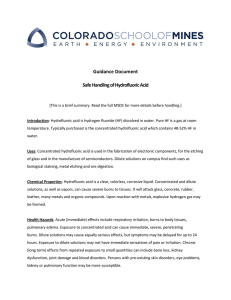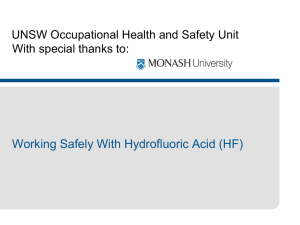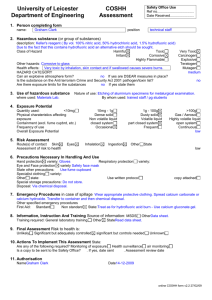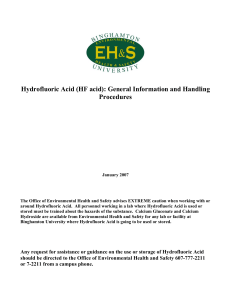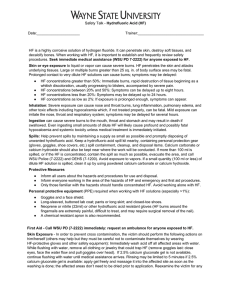Hydrofluoric acid, training presentation
advertisement
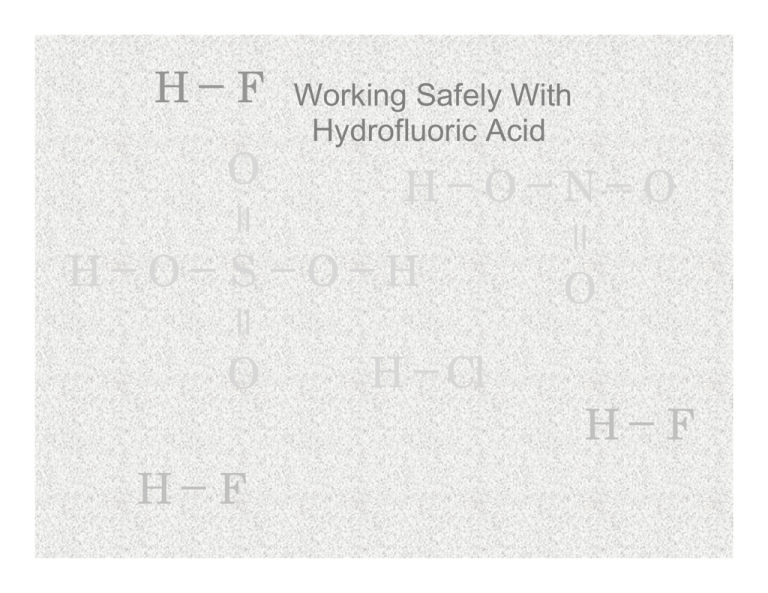
HrF Working Safely With Hydrofluoric Acid O HrOrNrO y y HrOrSrOrH O y HrL O HrF HrF Topics of Discussion •Properties of HF •Hazards Associated with HF •Handling and Storage •Proper PPE •Spills and Accidents •NDSU’s HF program What is Hydrofluoric Acid? Colorless liquid with strong irritating odor •Pungent odor at <1parts per million (ppm) warning property Nonflammable, very soluble in water Vapor density = 0.7 (air = 1) Irritation to nose and throat at 3ppm OSHA permissible exposure level (PEL) =3ppm(Avg 8 hour shift) OSHA Short term exposure limit (STEL) =6ppm (15 min) Immediately dangerous to life and health (IDLH) =30 ppm USES •Plastics Production •Microchip Etching •Electronic Circuit Cleaners •Glass Etching •Production & Purification of Radioactive Materials Hydrofluoric Acid (HF) is one of the strongest and most corrosive of the inorganic acids. Therefore, special safety precautions are necessary when using this chemical. HF acid burns are a unique medical problem. Dilute solutions deeply penetrate before dissociating, thus causing delayed injury and symptoms. Burns to the fingers and nail beds may leave the overlying nails intact. hazards •On contact with live tissue, produces immediate necrosis and pain at high concentrations •Serious Systemic Poison •Delayed health effects at low concentrations. Morbidity/mortality Local effects include tissue destruction and necrosis. Burns may involve underlying bone. Systemic fluoride ion poisoning from severe burns is associated with: •Hypocalcemia (low Calcium levels) •Hyperkalemia (low Potassium levels) •Hypomagnesemia (low magnesium levels) •sudden death. Deaths have been reported from concentrated acid burns to as little as 2.5% Body Surface Area (BSA). Exposure types Direct exposure Liquid exposure (skin, eye, ingestion) Gas/Vapor exposure (inhalation,skin & eyes) Exposure types Indirect or Secondary Exposure – Victims exposed to HF vapors only, do not pose a significant risk of secondary contamination Victims whose clothing or skin is contaminated with HF liquid or solution can secondarily contaminate response personnel by direct contact or through off-gassing vapors. Routes of Exposure • • • • Skin Respiratory Tract Eyes Ingestion(rare) Most HF exposures occur by: -inhalation of the gas/vapor -dermal contact SKIN HF is readily absorbed through the skin and deep tissue penetration by the fluoride ion ensues. HF binds to the calcium and magnesium in the body. The surface area of the burn is not predictive of effects. SKIN pathophysiology The 2 mechanisms that cause tissue damage are: –corrosive burn from the free hydrogen ions –chemical burn from tissue penetration of the fluoride ions. SKIN pathophysiology Fluoride ions penetrate and form insoluble salts with calcium and magnesium. Soluble salts also are formed with other cations but dissociate rapidly. Consequently, fluoride ions release, and further tissue destruction occurs. SKIN pathophysiology The initial extent of the burn depends on the concentration, temperature, duration of contact, and quantity Concentration Time to onset of symptoms 14.5% Immediately 12.0% Up to 1 hour 7% or less Several hours* *may take several hours before onset of symptoms, resulting in delayed presentation, deeper penetration of the un-dissociated HF, and a more severe burn. BURNS Weaker solutions penetrate before dissociating. *Surface involvement in these cases is minimal and may even be absent. Three categories of appearance: * A white burn mark and/or erythema and pain * A white burn mark and/or erythema and pain, plus edema and blistering * Ocular burns present with severe pain. Inhalation burns may develop acute pulmonary edema. BURNS Concentrated solutions cause immediate pain and produce a surface burn similar to other common acids with erythema, blistering and necrosis. •The pain is typically described as deep, burning, or throbbing and is often out of proportion to apparent skin involvement. •HF penetrates fingernails burning the pulp beneath without destroying the nails. Adequate treatment of these cases requires removal of the nails and/or intravenous and/or intra-arterial infusion of Calcium gluconate. EYES The eyes can be severely damaged from either vapor or liquid contamination Complications of eye exposure include corneal opacification, corneal sloughing, keratoconjunctivitis and necrosis of the anterior chamber. inhalation HF is a volatile liquid with a boiling point of only 19.5 C. Its volatility makes it a high risk compound for inhalation injury. Severity can range from mild airway irritation to severe burning and dyspnea. With inhalation of HF concentrations > 50% there is a significant risk that they will develop pulmonary edema/ARDS and pulmonary hemorrhage. inhalation Acute inhalation exposure symptoms include: chills fever tight chest coughing choking bluish colored lips and fingernails ingestion Poor lab practices coupled with inadequate personal hygiene after chemical use is the most common route of ingestion exposure. Prognosis: Varies depending on severity of burn and site of burn. The prognosis following HF inhalation is poor. Safe handling Substitute for less hazardous substance whenever possible Use the most dilute HF solution practicable ALWAYS work in a chemical fume hood at least 6” from the edge Good housekeeping! Safe handling •LABEL LABEL LABEL •use proper PPE •implement the buddy system •never work alone •order and keep on hand smallest quantity possible •cap when not in use (even during your work procedure) Safe handling use a bottle carrier when transporting HF (never transport open containers) check your spill/exposure kit contents and location before you start working check expiration date of the calcium gluconate BEFORE you start procedure Personal protection Eyes always use ANSI approved splash goggles. Consider full face shields Gloves 22 mil. Stanzoil neoprene or Stanzoil nitrile -remember the breakthrough time -consider arm covers or the length of the glove if there is a possibility of splash storage •use secondary containment •store away from incompatibles 9ammonia 9bases 9flammables and combustibles •store in acid resistant cabinet or liner •always store below eye level •cap when not in use •never use in a squirt bottle EMERGENCY RESPONSE General Procedure for All Exposures Do not panic! Think! Think! Think! Activate buddy system response immediately: 1. The buddy should call 911 - tell them: - you have a Hydrofluoric Acid exposure - the exact location - to send an ambulance and notify hospital 2. The buddy should call NDSU OSEH 231-7759 EMERGENCY RESPONSE Procedure for Skin Exposure: 1. Help individual to eyewash/safety shower: Do not contaminate yourself; use PPE) - 1-5 minutes in the safety shower - Victim should remove all contaminated items (i.e. clothing, shoes and jewelry while under the shower) - Remove goggles last, face water and pull over head EMERGENCY RESPONSE Procedure for Skin Exposure: 2. Buddy should bag all contaminated clothing and supplies (USE PPE) 3. Victim should self administer calcium gluconate: - if the victim is unable to administer, the buddy can assist using the neoprene gloves NOTE THE TIME OF INITIAL APPLICATION (may need to apply every 20 minutes until pain subsides or reaches medical facility) EMERGENCY RESPONSE 4. Take 6 Calcium Carbonate tablets (TUMS) if conscious 5. Inform Emergency Medical Personnel that calcium carbonate and calcium gluconate have been administered EMERGENCY RESPONSE Procedure for Eye Exposure 1. Use eyewash for 15 minutes – holding lid open (both lower and upper) for irrigation and wait for emergency response personnel 2. Conduct this process for both liquid or vapor contamination 3. Take 6 Calcium Carbonate tablets (TUMS) if conscious 4. Inform Emergency Medical Personnel that calcium carbonate was administered. EMERGENCY RESPONSE Procedure for Inhalation Exposure 1. Immediately remove the victim to clean air if it is safe to do so 2. Victim should ingest 6 calcium carbonate tablets if conscious and wait for emergency medical response 3. Inform Emergency Medical Personnel that calcium carbonate has been administered EMERGENCY RESPONSE General Notes: 1.The responding person or assisting lab personnel must escort the victim to the hospital. 2. A copy of the MSDS, the calcium carbonate tablets, the calcium gluconate gel and these emergency procedures must be also taken to the hospital. spills General Procedure for All HF Spills Please follow basic spill procedures: 1. Alert others in the area 2. Contain the spill if safe to do so 3. Cordon off area 4. Leave the area, contact 911 and x1-7759 and specify that you have a hydrofluoric acid spill. 5. Let spill response personnel know where you will be so that they can meet you for additional information 6. OSEH is responsible for the clean up of all HF spills. Safe use 1.Never use Hydrofluoric Acid when working alone or after hours. The buddy system must be implemented whenever using HF. Everyone working with or around HF must have the NDSU HF training before commencing any work and an annual refresher training thereafter. . Safe use 2. A sign should be posted to alert people that work with Hydrofluoric Acid is in progress. 3. Everyone working with HF must be properly trained on the appropriate waste management. 4. Laboratories which keep or use Hydrofluoric Acid gas or concentrated solutions (>1% Hydrofluoric Acid) should have these emergency procedures on hand as well as an MSDS. All HF gas cylinders must be kept in vented gas cabinets. Safe use 5. Laboratories which keep or use Hydrofluoric Acid gas or concentrated solutions (>1% Hydrofluoric Acid) must have an operational safety shower and eye wash in their laboratory. a. Before beginning any procedure involving Hydrofluoric Acid, make sure the access to the emergency shower and eyewash is unobstructed. Safe use 6. Undergraduate students should never be given the task of mixing Hydrofluoric Acid solutions. Only experienced persons familiar with its properties should handle the concentrated acid. Safe use 6. Undergraduate students should never be given the task of mixing Hydrofluoric Acid solutions. Only experienced persons familiar with its properties should handle the concentrated acid. 7. Any exposure to Hydrofluoric Acid must be medically evaluated Safe use When working with Hydrofluoric Acid or concentrated HF solutions (> 1%): a. No HF work is to be conducted outside of a properly operating fume hood that has a current monitor sticker. b. All work must be conducted in a secondary container inside he chemical fume hood. c. Work in a fume hood with the sash as low as possible. Safe use d. Wear goggles and a face shield. Wear a longsleeved, buttoned lab coat, pants or long skirt, and closed-toe shoes. Wear Stanzoil Neoprene or Stanzoil Nitrile (22mil) gloves or other Hydrofluoric Acid resistant gloves (Hydrofluoric Acid burns around the fingernails are extremely painful, difficult to treat, and may require surgical removal of the nail). A chemically resistant apron is also recommended. waste Waste Disposal Procedures Regardless of the concentration of HF, it may not be put down the drain. It may also not be neutralized and put down the drain. Collect waste HF in a clearly labeled, appropriate container with a screw cap. Glass and metal are unsuitable containers. Do not mix different kinds of acids together. Hazardous waste labels are available from the Safety Office. When the waste container is sufficiently full or when the experiment using HF is complete, contact the Safety Office (ext. 1-7759) for pick up.
